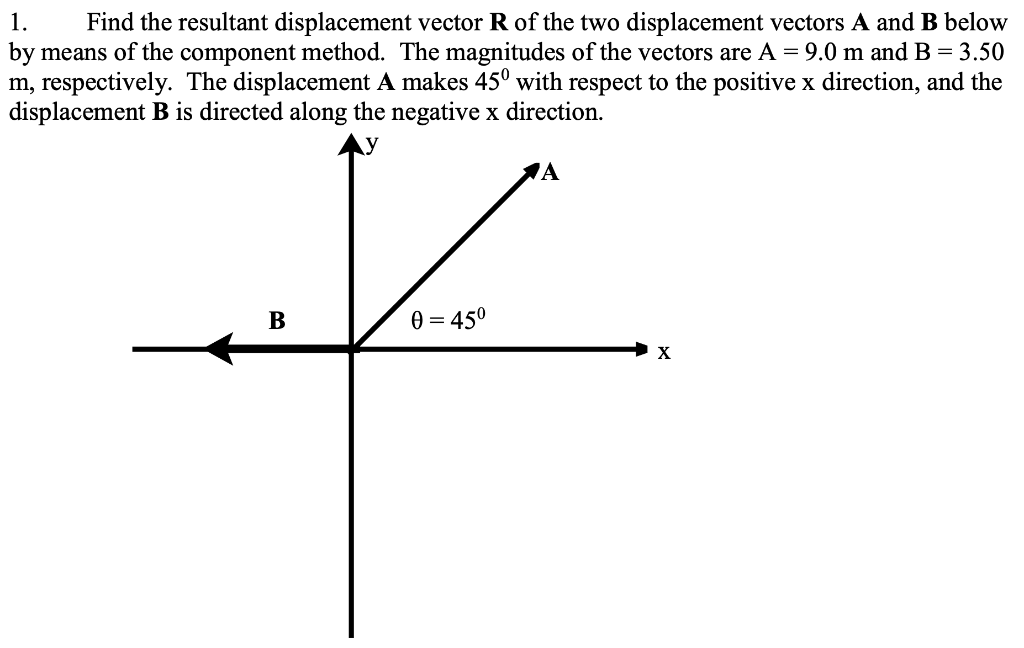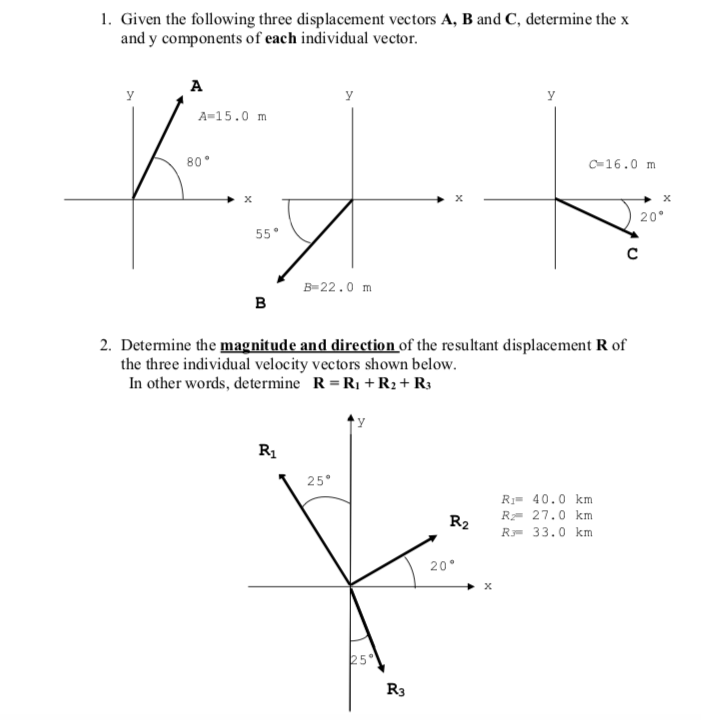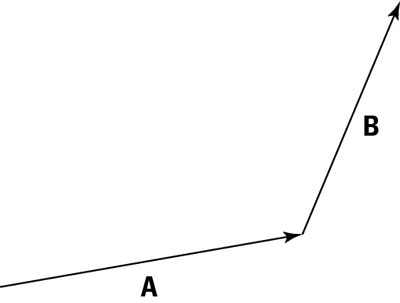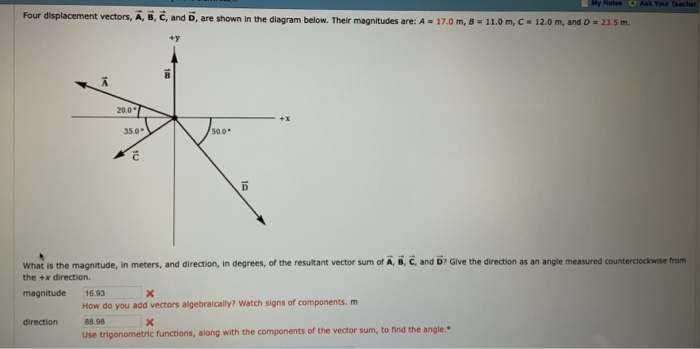Resultant For Displacement Vectors
The resultant of the three displacement vectors OPPQ and QR is. The angle of a vector is relative its own tail.

1 Find The Resultant Displacement Vector R Of The Chegg Com
If displacement vectors A and B are added together the result will be vector R which is the resultant vector.

Resultant for displacement vectors. Use a protractor to MEASUREthe resultant angle. If A and B represent two legs of a walk two displacements then R is the total displacement. R- units b Find the magnitude and direction of the resultant displacement.
Therefore So the resultant. The head to tail method to calculate a resultant which involves lining up the head of the one vector. The graphical method of adding vectors A and B involves drawing vectors on a graph and adding them using the head-to-tail method.
Use a ruler to MEASUREthe resultant length. The resultant is the vector sum of two or more vectors. In this section we will look at a few applications where we will use resultants of vectors to find speed direction and other quantities.
August 23 2021 at 850 PM 1 Three displacement vectors of a croquet ball are shown in the figure where Al 230 units IBI 600 units and Cl 200 units. The resultant vector is the vector that results from adding two or more vectors together. A displacement is a distance considered as a vector.
Cos 370 45. The displacement A makes 450 with respect to the positive x direction and the displacement B is directed along the negative x direction. But any two vectors can be added as long as they are the same vector quantity.
If you are adding more than two either deal with them two at a time add two and get a resultant then add the next vector to that resultant and so on or break all the given vectors down into their individual components at the start and sum the like-components all at once. The magnitude and direction of R are then determined with a ruler and protractor respectively. ECCECCA A 450 450 X 10 a Find the resultant in unit-vector notation.
A displacement vector gives the change in position. Then to point C 400 m eters west. Then to point D 200 m eters south.
Vector displacement problems and solutions 1. The resultant R is drawn from the tail of the first to the head of the last vector. Magnitude of displacement by graphical method is shown below.
Mathematical Operations on Vectors. The distance from the starting point to the ending point is the magnitude of the displacement vector and the direction traveled is the direction of the displacement vector. Finding the Resultant of Two Displacements.
Going from the tail of one vector to the head of. Find her total distance R from the starting point and the. Sin 60 o 087 cos 60 o 05.
But any two vectors can be added as long as they are the same vector quantity. It is given first displacement is 30 m due south. Therefore Then 30 m due east.
And then finish at point E 700 m eters east. Motion in a Plane. By means of the component method.
The magnitudes ofthe vectors are A 90 m and B 350 m. Methods for calculating a Resultant Vector. Draw the vectors Tip to Tail IMPORTANT.
You can use analytical methods to determine the magnitude and direction of R. Combine the resulting component sums into a final resultant vector. From the vector principle when two vectors are perpendicular to each other then their resultant magnitude is given by R P 2 Q 2 30 2 30 2 18000 13416 m.
Click hereto get an answer to your question Find out the magnitude of resultant of two displacement vectors each having a y - component of 10 km are added together to form a resultant that forms an angle of 60 o from the x - axis. The resultant vector R is defined such that A B R. A person walks from point A to point B 600 m eters north.
There are a two different ways to calculate the resultant vector. Vectors A and B are two legs of a walk and R is the resultant or total displacement. Magnitude unit s direction .
When displacement vectors are added the result is a resultant displacement. To find the resultant displacement in a physics problem apply the Pythagorean formula to the distance equation and use trigonometry to find the direction of movement. About Press Copyright Contact us Creators Advertise Developers Terms Privacy Policy Safety How YouTube works Test new features Press Copyright Contact us Creators.
We can use vectors to find direction velocity and force of moving objects. Find the resultant displacement vector R of the two displacement vectors A and B belovw 1. If two or more velocity vectors are added then the result is a resultant velocity.
College Physics 324 Resultant displacement of a pilot. If two or more force vectors are added then the result is a resultant. Suppose a pilot flies 400 km in a direction 60 north of east and then flies 300 km in a direction 15 north of east as shown in Figure 361.

1 Given The Following Three Displacement Vectors A Chegg Com

The Displacement Vector A And B When Added Together Give The Resultant Vector R So That R A B Use Brainly Com

5 1 Vector Addition And Subtraction Graphical Methods Texas Gateway

The Displacement Vectors A And B When Added Together Give The Resultant Vector R So That R A B Use The Data In The Drawing And The Fact That Psi

Calculating The Resultant Vector Of Two Displacement Vectors Dummies
Answer In Physics For Jamal 95885

The Component Method Of Finding A Resultant Youtube

Four Displacement Vectors A B E And D Are Shown Chegg Com
Position And Displacement Vectors Geeksforgeeks

Problem 3 33 Points The Following Displacement Chegg Com

Vector Addition Example Resultant Displacement Youtube
C 50 M Find A The Resultant In Unit Vector Chegg Com

Determine Resultant Of Two Vectors Using Pythagorean Theorem Solved Problems In Basic Physics
Find The Resultant Displacement Vector R Of The Two Chegg Com

Finding Magnitude And Direction Of Resultant Vectors Youtube

18 The Displacement Vectors A And B When Added Chegg Com






Posting Komentar untuk "Resultant For Displacement Vectors"